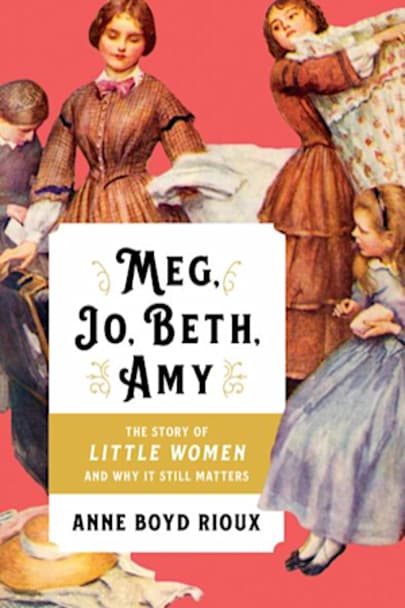In Meg, Jo, Beth, Amy, Anne Boyd Rioux brings a fresh and engaging look at the circumstances leading Louisa May Alcott to write Little Women and why this beloved story of family and community ties set in the Civil War has resonated with audiences across time.



Reading Anne Boyd Rioux’s engaging Meg, Jo, Beth, Amy: The Story of Little Women and Why It Still Matters, has made me pick up Alcott’s novel yet again with renewed insight and inspiration. Every fan of Little Women will delight in reading this book. And all the women ― and men ― who haven’t read the novel will race to it after reading Rioux.
A wonderful behind-the-scenes look at the life of Louisa May Alcott and how she came to write the beloved Little Women. It sent me digging back into my Kindle stash to re-read the classic.
2018 marks the 150th anniversary of Louisa May Alcott’s Little Women, a novel which became a trendsetter best seller, influencing generations of girls.
Anne Boyd Rioux’s new book Meg, Jo, Beth, Amy: the Story of Little Women and Why They Still Matter celebrates the novel’s history, legacy, and influence.
Meg, Beth, Jo, Amy is more than a nostalgic look at the novel, for Rioux seeks to answer the question of what the novel offers to young readers today. Is it still relevant?
But first, she turns her attention to The Making of a Classic, presenting Alcott ‘s family and personal history, how they were fictionalized in the novel, how she came to write the novel and its early success.
Although the novel was inspired by the Alcott’s family experiences, it was a very much idealized version of their life. Bronson Alcott held ideals that did not include worldly considerations so that his wife and daughters had to struggle to provide for their daily needs. He may have had episodes of mental instability. Louisa was perhaps a genius, but she also had to write to contribute to the family coffers.
Alcott never meant to marry off all the March girls, save Beth who dies. But the publisher insisted. Jo was at least allowed to marry on her own terms, and her husband and she run a school together.
This section alone was fascinating for those of us who love the novel.
The various printings of the novel, the illustrators (including those by May Alcott) are also presented.
In Part II, The Life of a Classic, follows the novel’s adaptation for the screen and stage–including a musical and an opera–and their influence. I recently viewed the last adaptation, the BBC/PBS television series on Masterpiece Theater, which I very much enjoyed.
Rioux then turns her attention to the novel’s Cultural and Literary Influence, including how it has dropped off the literary canon and has been marginalized as a ‘girl’s book.’ And yet the novel had “more influence on women writers as a group than any other single book,” Rioux writes, and she quotes dozens of writers extolling its inspiration. Little Women’s legacy includes novels such as Anne of Green Gables by L. M Montgomery and Hermonine Granger in the Harry Potter novels by J. K. Rowling.
Is the novel an idealized version of life, or does it reflect reality? G. K. Chesterton thought Alcott “anticipated realism by twenty or thirty years,” while many 20th c writers found it preachy and, in short, too feminine. Gloria Steinem and Germaine Greer both loved Little Women, while other feminists rejected the novel.
Is Little Women still relevant today, and why should it continue to be read, is probed in Part III: A Classic for Today.
In recent years fewer children have read Little Women, and that is in part because educational standards became slanted toward boys and their needs and interests. Even if Teddy Roosevelt liked the book as a boy, today’s boys won’t pick up a book that is girlish. That’s why some writers use initials instead of first names–so the boy readers won’t know the books are written by a female! Sadly, few books by women appear on school reading lists.
What is lost when boy don’t read about family and community? Have we ‘hypermasculinized’ boys and condoned intolerance of the feminine?
Last of all, Rioux looks at the role models girls today have, from Disney princesses to the action heroines and warrior princesses, Rory Gilmore to Girls.
As a novel about young girls growing up, the March sisters offer readers images of what it means to be a girl and the choices girls have.
The novel, Rioux says, “is about learning to live with and for others,” and it is about the compromises we make in life.
I highly recommend this book.
I grew up with Little Women and I enjoyed this book because it reminded me of the reason why I loved Louisa May Alcott. If you weren’t sure of the importance of Little Women, read this book.